Centenary University (NJ)
Centenary University (visited 11/12/19)

The main building as seen through the gates from the street.
My visit totally started off on the wrong foot. I arrived about 20 minutes early for my 2pm tour. I arrived at the given address and found the large main building with the gold dome; it’s hard to miss. However, there’s no parking to be found. No visitor lot, no signs for admissions parking, nothing to direct people arriving from off campus. No signage is a huge red flag for me. I circled the area, pulled onto a couple small roads into campus thinking it might lead me somewhere. I saw a lot of old buildings, nothing that looked well kept up, no signs for anything. Pulling onto another main road, I saw a small (like the size of a sheet of paper) sign that said “Centenary Parking” with an arrow. I followed it. Saw another one indicating I was still in the right direction. I ended up at the Hackettstown train station about 3 blocks from campus (which is a bonus, I’ll say – so there’s a plus in the university’s favor). I pulled into the lot and called the admission office, explaining that I had no idea where I should be going or parking. “Oh, you need to park on the street!” – which they never indicated on the website or in any of the emails confirming my visit. I explained that I had been circling for about 10 minutes; no spots available. “Then just go to this other place.”

The balcony of the chapel which sits under the gold dome.
I finally found someone who had pulled out, I parked on the street, and I made my way into the building. Right inside the main doors is a Welcome Center; I figured that was maybe the admission hub since there were no other signs for admissions. I thought that was great! A lot of schools don’t have that. I went in, introduced myself, and said I was there for the 2pm tour. “You’re in the wrong spot. You want Admissions.” Nothing else. Ok … where would that be?? I got pointed in the right direction.
I seriously almost walked away at that point. It’s hard to feel good about a place that seems to almost go out of its way to not welcome people – especially when they’re trying to get enrollment up. How can I recommend a place in good faith when I’m not sure that students will be taken care of, and that starts with visiting Admissions.

The main quad where there are often activities held, including a massive Easter Egg hunt,
Once I got into Admissions (at least it was just around the corner from the Welcome Center), the student worker at the desk was friendly, and things turned around a bit. I introduced myself, and he was enthusiastic and told me that he was going to be the one taking me on tour. While I was waiting for him to get his coat, none of the admissions officers who saw me come in introduced themselves or said hello … and this office was NOT busy. I was the only visitor there; I heard no phones ringing; nothing much seemed to be going on. As a side note, the woman who I had been emailing/talking to also never introduced herself.
 The tour was fairly quick – maybe 40 minutes, and we dawdled because I asked a lot of questions. He was totally not scripted and was good about answering things openly. As a senior, he’s got a lot to say, and I walked away feeling like I had a decent grasp on the place.
The tour was fairly quick – maybe 40 minutes, and we dawdled because I asked a lot of questions. He was totally not scripted and was good about answering things openly. As a senior, he’s got a lot to say, and I walked away feeling like I had a decent grasp on the place.
So, here’s what I can say about Centenary:
- This is a great school for students who are maybe C students in high school and who need small classes and possibly academic support: they offer a couple for-pay support programs.
- “There’s a lot of support here. I failed a couple classes my freshman year, and people worked with me to help me do them over and figure out what I needed to do. I ended up doing very well here,” said my tour guide.
- Project ABLE (Academic Bridges to Learning Effectiveness) and STEP (Summer Transition and Enrichment Program) Ahead offer individual and small group skill building and support for academics, including organization and/or remediation.
 It has a spectacular Equestrian Center. The center is about 8 miles away, about a 15-minute drive through some very pretty countryside.
It has a spectacular Equestrian Center. The center is about 8 miles away, about a 15-minute drive through some very pretty countryside.
- “The center is amazing; the classrooms are right there and you can actually watch people riding and doing the things you’re talking about in class.”
- They offer Equine Studies with a variety of concentrations, including: Equestrian Media/PR, Equine Business Management, Equine Training/Instruction, Animal Health (pre-vet track), Equine Science, and Equine Studies.
-

One of the classrooms in the equestrian center that looks onto the indoor arena
They run shuttles several times an hour to and from the center; they even have a kitchen there “Because a lot of them are there for a big chunk of the day for classes and riding; they can even use their meal swipes out there.”
- They have a very cool “double-decker” (2-storey) chapel on the 2nd and 3rd floors of the main building.
- Campus facilities leave a lot to be desired, although they’re slowly improving upon them.
-

The interior of the new theater lobby. The black box theater is straight ahead; the large theater is the left.
They have new theater facilities which brings in community members both to perform and as audience members.
- Their DIII athletic teams draw fans, including wrestling, but I get the feeling that it’s because there’s not a ton of other things to do.
- It’s very much a regional school (70% from NJ) with a lot of commuters. “One of my friends commutes from Newark which is like an hour away.”
- They offer 2 cool freshman dorms (attached to the main building), 2 transfer student dorms (which is incredibly smart of them), a couple sophomore dorms (“Middle Campus”) and 2 fairly new Apartment-style buildings. The apartments have 4 singles, 2 baths, a living room, and a kitchen. “You can move in here as soon as sophomore year, but usually only if you have older friends who are willing to have you live with them.”
-

The Middle Campus (sophomore) dorms
They have a “Move In Crew” – volunteers from a bunch of clubs that will help unload stuff from onto golf carts and will bring them to the dorms.
- There is no residency requirement.
- Housing is more difficult off campus because “it’s an older town and it’s hard to find landlords to rent out houses, but there are some, and there are some apartment complexes not too far away.”
-

The Science (and fashion) building
Students have to complete 10 hours of community service. “Most of them get it done in freshman year because there’s a service project they do as a group during orientation.”
- Enactus is a social entrepreneurship organization and/or class. Students can get a Social Media Marketing My tour guide loved this and got a social media internship between junior and senior years which he credits entirely to Enactus and his concentration.
- They offer a fashion design major – which is housed in the science building. I didn’t get to go in and see the labs, but the building looked like an old elementary school.
- Town is small. “It’s hard to get food late-night, so the school has offered some late night options. People love that!”
© 2019
 The Camden branch is the smallest of the 3 Rutgers campuses with about 5000 undergraduates, only 600 of whom live in the 3 dorms buildings. There are no traditional-style dorms; freshmen live in 3-bedroom/6-person suites; upperclassmen get their own bedrooms in suites or apartments. All rooms have a fridge and microwave, AC, and cable.
The Camden branch is the smallest of the 3 Rutgers campuses with about 5000 undergraduates, only 600 of whom live in the 3 dorms buildings. There are no traditional-style dorms; freshmen live in 3-bedroom/6-person suites; upperclassmen get their own bedrooms in suites or apartments. All rooms have a fridge and microwave, AC, and cable.




 It is possible to transfer between the Rutgers campuses, but it’s not guaranteed. The admissions rep said that it’s considered an internal transfer and “it’s up to the Schools. They make the decision if you can move. It’s probable. It’s not for sure.”
It is possible to transfer between the Rutgers campuses, but it’s not guaranteed. The admissions rep said that it’s considered an internal transfer and “it’s up to the Schools. They make the decision if you can move. It’s probable. It’s not for sure.”
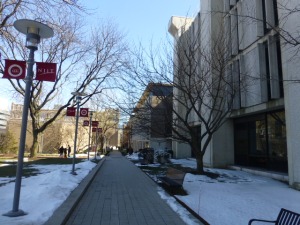 NJIT is a physically small campus (2×2 city blocks) located right in Newark. It has managed to combine the best of a central campus feel with the urban environment. The central Plaza is separated into Upper Green (there’s currently construction going on) and Lower Green (filled with bouncy houses and other activities when I visited during mid-afternoon).
NJIT is a physically small campus (2×2 city blocks) located right in Newark. It has managed to combine the best of a central campus feel with the urban environment. The central Plaza is separated into Upper Green (there’s currently construction going on) and Lower Green (filled with bouncy houses and other activities when I visited during mid-afternoon).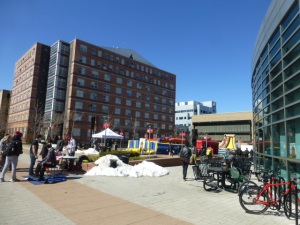 Because of its location (and because of the in-state tuition), it remains very much a commuter school with only about 25% of students living on campus. Commuters are well taken care of here with regular events for commuters to help them connect to others and the school. My tour guide was a commuter and loved it; he never felt like he wasn’t part of the school, and did spend a great deal of time on campus. If he could change anything about the school, he would add sleeping pods in the library. “Students who live in dorms can nap during the day. Commuters are sometimes here 10-14 hours a day, and it would be nice to be able to nap in our down-time!” The big parking garage provides plenty of space for drivers; an app shows how many open spots there are so they don’t waste time driving through the garage looking. Commuters pay less than resident students.
Because of its location (and because of the in-state tuition), it remains very much a commuter school with only about 25% of students living on campus. Commuters are well taken care of here with regular events for commuters to help them connect to others and the school. My tour guide was a commuter and loved it; he never felt like he wasn’t part of the school, and did spend a great deal of time on campus. If he could change anything about the school, he would add sleeping pods in the library. “Students who live in dorms can nap during the day. Commuters are sometimes here 10-14 hours a day, and it would be nice to be able to nap in our down-time!” The big parking garage provides plenty of space for drivers; an app shows how many open spots there are so they don’t waste time driving through the garage looking. Commuters pay less than resident students.
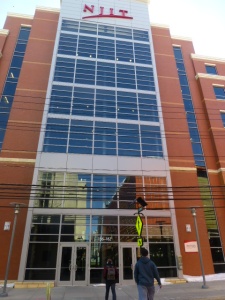
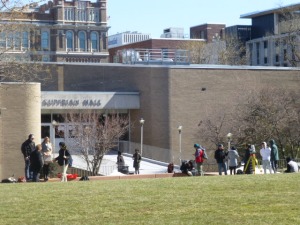
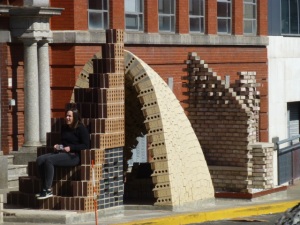

 “We’re the #1 school for most squirrels and in the top 10 for most haunted campus. Interesting but irrelevant,” said the tour guide.
“We’re the #1 school for most squirrels and in the top 10 for most haunted campus. Interesting but irrelevant,” said the tour guide.
 Students looking for strong humanities (including
Students looking for strong humanities (including 


 Drew was founded as a Methodist Seminary but is no longer affiliated, although the largest Methodist Archive in the country is located here. They’re nationally recognized for civic engagement, and they run a
Drew was founded as a Methodist Seminary but is no longer affiliated, although the largest Methodist Archive in the country is located here. They’re nationally recognized for civic engagement, and they run a 


 This is still heavily Catholic with Sisters living on and around campus. There is a Mass during orientation, and they’re offered daily but not required.
This is still heavily Catholic with Sisters living on and around campus. There is a Mass during orientation, and they’re offered daily but not required.

 The academic offerings are limited, but students are allowed to take classes at Drew and at the nearby Fairleigh Dickenson campus. “There’s a path that leads right onto their athletic fields. It’s easy to get over there.” Drew is about 10 minutes away. She had a friend take music classes there; she didn’t have a car, but the school got her transportation over.
The academic offerings are limited, but students are allowed to take classes at Drew and at the nearby Fairleigh Dickenson campus. “There’s a path that leads right onto their athletic fields. It’s easy to get over there.” Drew is about 10 minutes away. She had a friend take music classes there; she didn’t have a car, but the school got her transportation over.
 Students are engaged with each other and lots were wearing Seton Hall gear. There were so many students around that I was surprised to learn that students were actually on break. 80% of freshmen and 50% of total undergrads live on campus. Housing is not guaranteed, but they’ve never had a student denied if they’ve applied by the deadline. RAs and priests live in each of the 6 residence halls; they also provide 2 apartment buildings for upperclassmen.
Students are engaged with each other and lots were wearing Seton Hall gear. There were so many students around that I was surprised to learn that students were actually on break. 80% of freshmen and 50% of total undergrads live on campus. Housing is not guaranteed, but they’ve never had a student denied if they’ve applied by the deadline. RAs and priests live in each of the 6 residence halls; they also provide 2 apartment buildings for upperclassmen. Students feel that there’s enough to do on campus. As a founding member of the Big East, their 14 DI sports teams are a big draw, particularly basketball. Tickets cost $100 for the season (refunded if they go to all the games). Another student raved about the fact that Seton Hall won “Best College Christmas Tradition”: on the first Monday of December, they light the large outdoor tree, sing carols, and have hot chocolate.
Students feel that there’s enough to do on campus. As a founding member of the Big East, their 14 DI sports teams are a big draw, particularly basketball. Tickets cost $100 for the season (refunded if they go to all the games). Another student raved about the fact that Seton Hall won “Best College Christmas Tradition”: on the first Monday of December, they light the large outdoor tree, sing carols, and have hot chocolate. One student told me that campus can be quiet on the weekends. However, there’s no shortage of things to do. Many students choose Seton Hall because of its proximity to NYC. The train station is a 10-minute walk (or quick shuttle ride) from campus; from there, it’s a 30-minute ride into Penn Station. Luckily, the train station is on the “good side” of campus. I was worried as I drove in: an area close to campus was run-down with boarded-up/gated storefronts, garbage, and people literally wandering in the streets. Suddenly, within a block or two of campus, things changed. “One side of campus is shady; the other is a mega-rich neighborhood,” said students. Campus is beautiful, safe, and gated; students swipe in, and visitors check in with a guard.
One student told me that campus can be quiet on the weekends. However, there’s no shortage of things to do. Many students choose Seton Hall because of its proximity to NYC. The train station is a 10-minute walk (or quick shuttle ride) from campus; from there, it’s a 30-minute ride into Penn Station. Luckily, the train station is on the “good side” of campus. I was worried as I drove in: an area close to campus was run-down with boarded-up/gated storefronts, garbage, and people literally wandering in the streets. Suddenly, within a block or two of campus, things changed. “One side of campus is shady; the other is a mega-rich neighborhood,” said students. Campus is beautiful, safe, and gated; students swipe in, and visitors check in with a guard. Academics are student-centered, and students like the atmosphere: “We’re pretty chill here. It’s cooperative,” said the tour guide. Freshmen are assigned both an academic and a peer advisor, and they’re enrolled in a 1-credit University Life class to help transition into college. Students get a laptop when they start and a new one 2 years later (they can keep that one after graduation). They rank in the top 5 universities (keeping company with places like UPenn and Duke) for internships: over 80% of students complete at least 1. Clearly they’re doing something right: they’ve had 18 Fulbright awards since 2009.
Academics are student-centered, and students like the atmosphere: “We’re pretty chill here. It’s cooperative,” said the tour guide. Freshmen are assigned both an academic and a peer advisor, and they’re enrolled in a 1-credit University Life class to help transition into college. Students get a laptop when they start and a new one 2 years later (they can keep that one after graduation). They rank in the top 5 universities (keeping company with places like UPenn and Duke) for internships: over 80% of students complete at least 1. Clearly they’re doing something right: they’ve had 18 Fulbright awards since 2009. The size of the school “offers all the advantages of a large research university but the support of a small school,” said the admissions rep. Classes average 21 students with Freshman English averaging 15 and languages capped at 15. The tour guide’s larges class was 30 (Intro to Bio) and smallest was 15 (Freshman Eng). Another student’s smallest class was 7 (Russian).
The size of the school “offers all the advantages of a large research university but the support of a small school,” said the admissions rep. Classes average 21 students with Freshman English averaging 15 and languages capped at 15. The tour guide’s larges class was 30 (Intro to Bio) and smallest was 15 (Freshman Eng). Another student’s smallest class was 7 (Russian). There are two early deadlines to be aware of for scholarships. First, students interested in
There are two early deadlines to be aware of for scholarships. First, students interested in 
 The 3000 undergraduates (still skewed towards male, but better than the 70-30 ratio from a couple years ago) take full advantage of all the on- and off-campus offerings. Housing is guaranteed for all 4 years, but students are only required to live on campus for the first year. The university runs some off-campus apartments for students to lease; these are available only for a full-calendar year, great for students who are doing co-ops or internships. These are all within a 15-minute walk, and shuttles are available. New York City is only a 10-minute ride away on Path. “Off campus, students don’t miss Washington Street Wednesday. We can use our meal cards at participating restaurants. A meal there equals 1 meal swipe.” They also have NYC at their disposal, including discounted tickets for shows.
The 3000 undergraduates (still skewed towards male, but better than the 70-30 ratio from a couple years ago) take full advantage of all the on- and off-campus offerings. Housing is guaranteed for all 4 years, but students are only required to live on campus for the first year. The university runs some off-campus apartments for students to lease; these are available only for a full-calendar year, great for students who are doing co-ops or internships. These are all within a 15-minute walk, and shuttles are available. New York City is only a 10-minute ride away on Path. “Off campus, students don’t miss Washington Street Wednesday. We can use our meal cards at participating restaurants. A meal there equals 1 meal swipe.” They also have NYC at their disposal, including discounted tickets for shows.



























